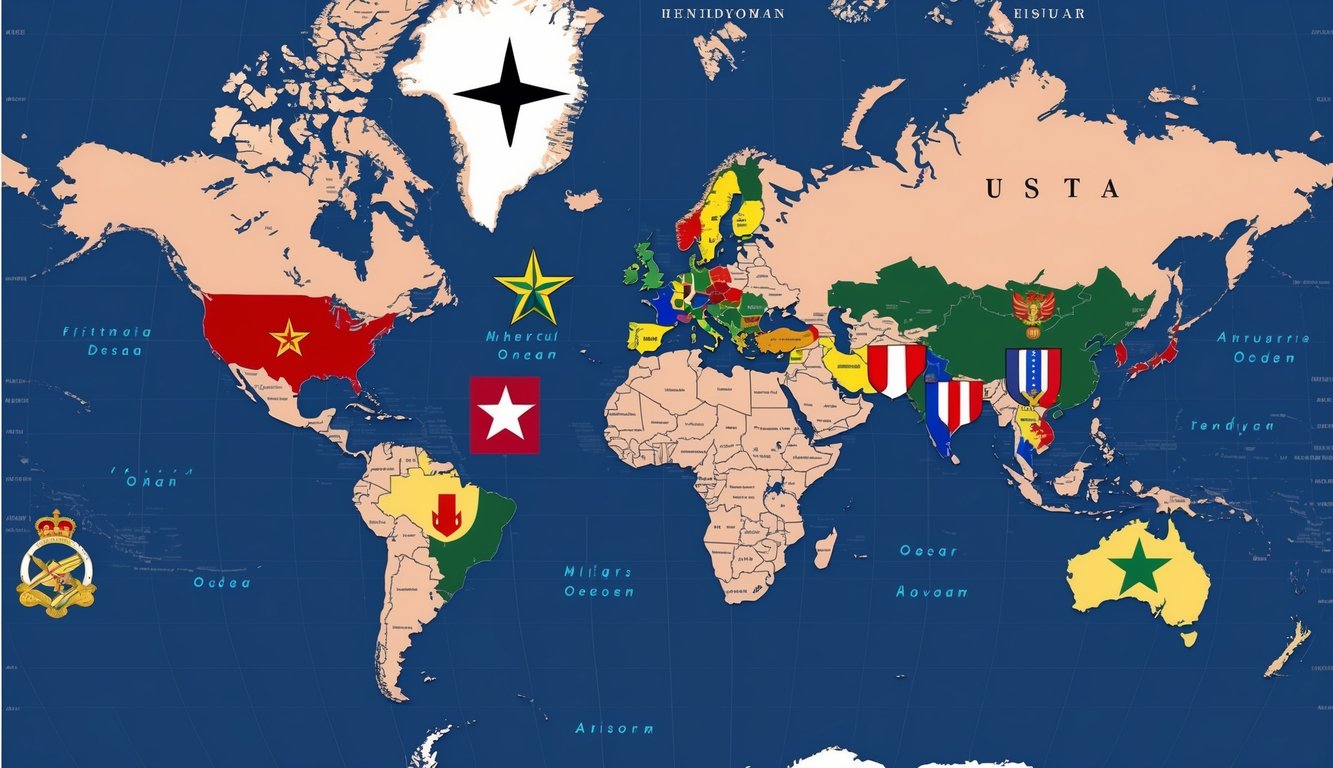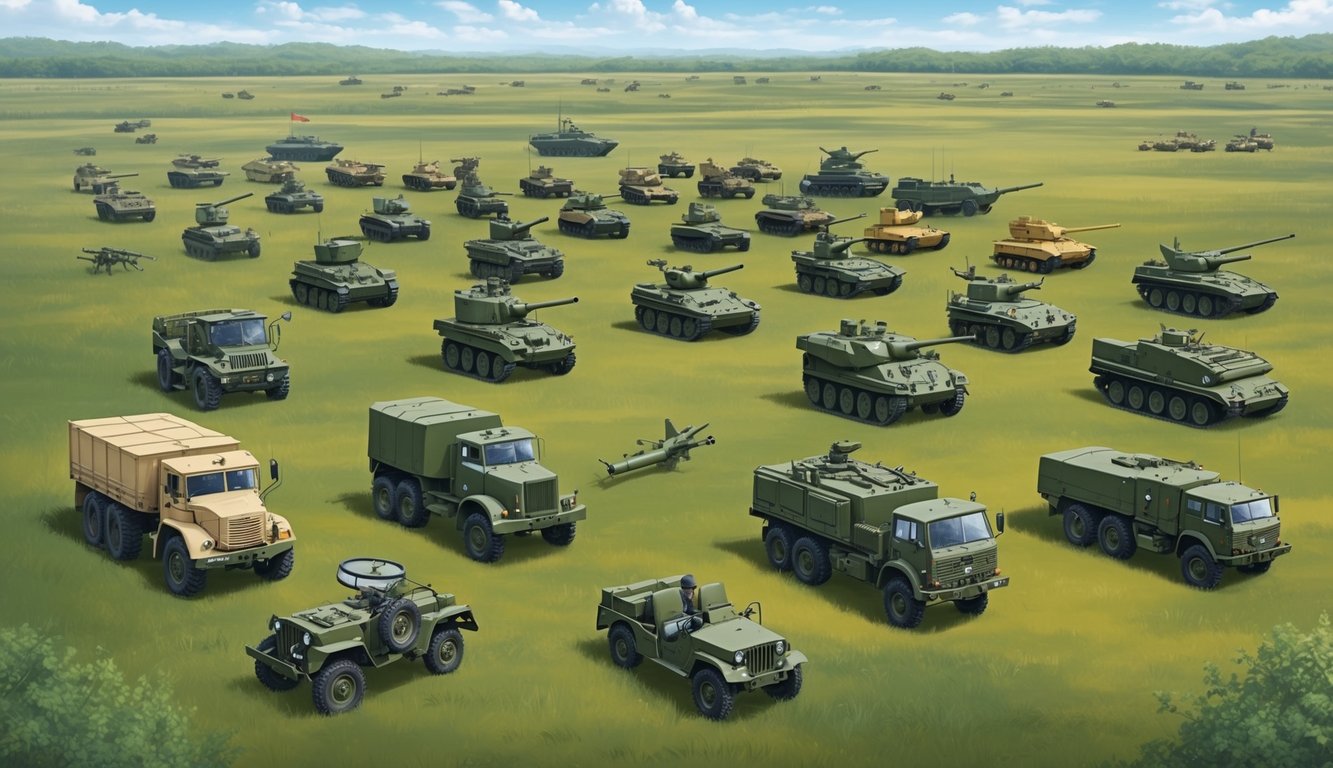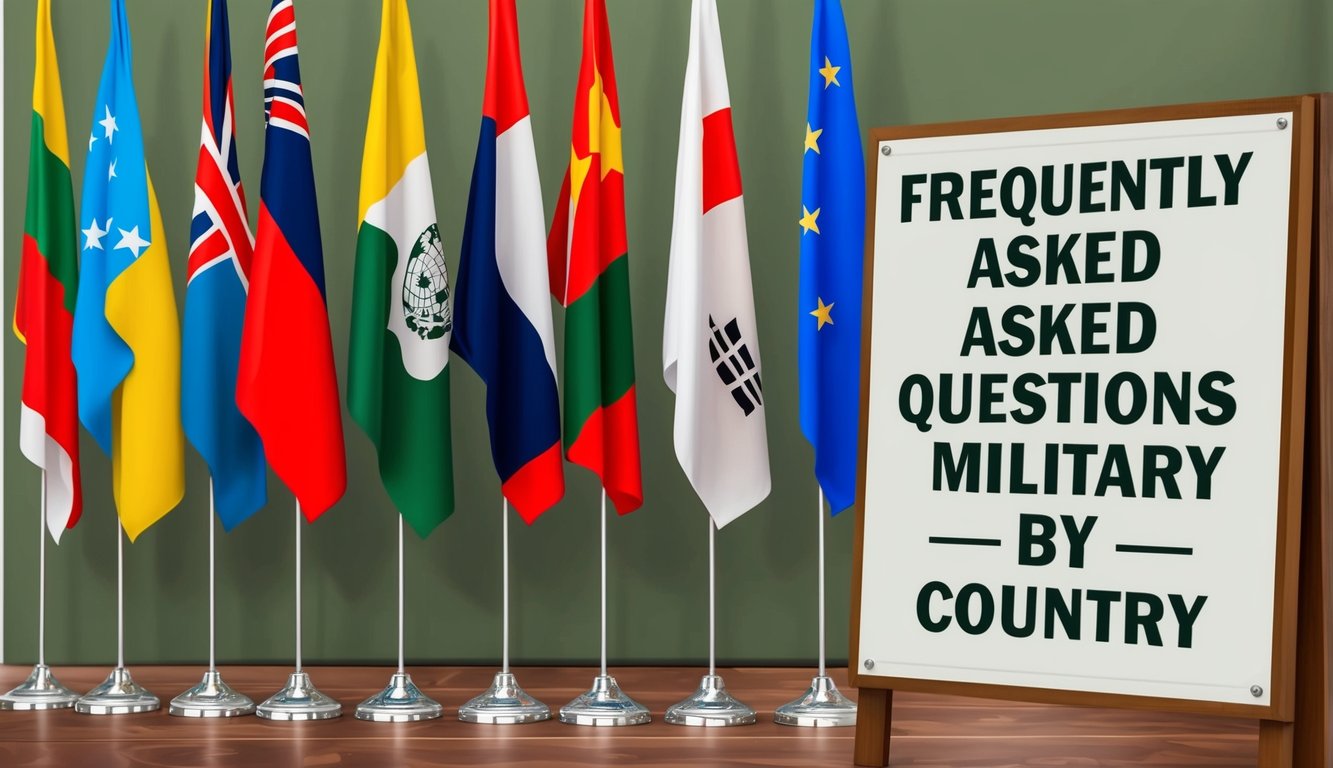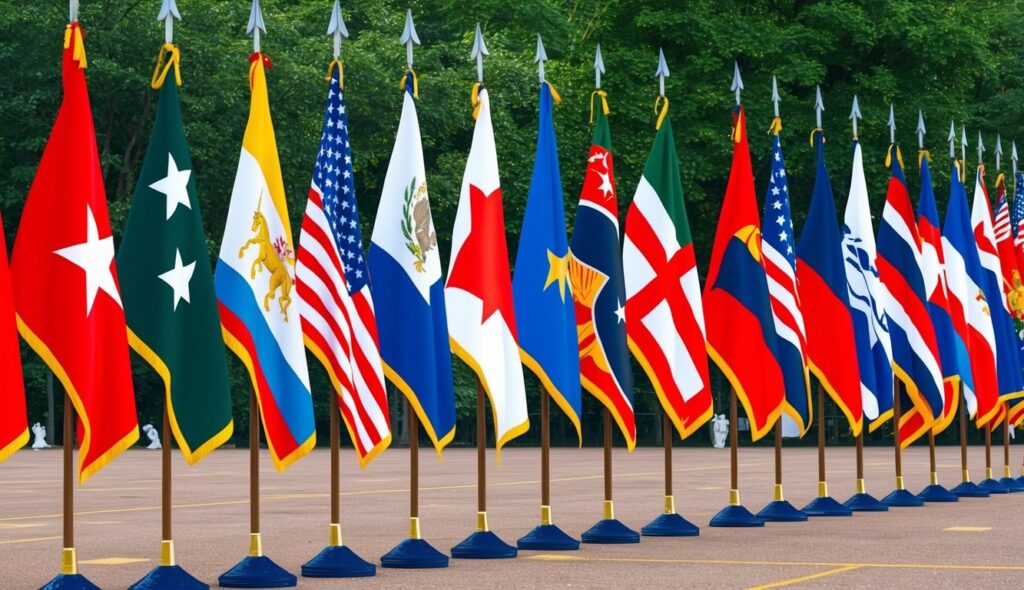Military power plays a crucial role in shaping global politics and international relations. Countries worldwide maintain armed forces of varying sizes and capabilities to protect their interests and ensure national security. The United States, China, and Russia are widely recognized as the top three military powers globally, based on factors such as personnel strength, equipment, and defense spending.
When comparing militaries by country, it’s important to consider various aspects beyond just troop numbers. These include technological advancements, training quality, and strategic alliances.
For instance, while North Korea boasts a large number of military personnel per capita, its overall effectiveness may be limited by outdated equipment and economic constraints.
Understanding the military capabilities of different nations can provide valuable insights into geopolitical dynamics and potential areas of conflict or cooperation. As you explore this topic further, you’ll discover how factors like geography, economic resources, and historical context shape each country’s approach to defense and military strategy.
Key Takeaways
- Military strength varies greatly among countries, with factors beyond troop numbers influencing overall capabilities.
- Technological advancements and strategic alliances play significant roles in determining a nation’s military effectiveness.
- Understanding global military dynamics can provide valuable insights into international relations and potential areas of conflict or cooperation.
Global Military Overview
Military strength varies widely across nations, with some maintaining powerful armed forces while others have no formal military. Global rankings assess countries’ military capabilities, though a few nations stand out for unique recruitment practices.
Global PowerIndex Ranking
Global Firepower’s annual ranking evaluates over 60 factors to determine military strength. The United States consistently tops the list, followed by Russia and China. These rankings consider active personnel, equipment, and logistics capabilities.
You’ll find smaller nations like Israel and South Korea punching above their weight due to advanced technology and compulsory service. The index also factors in geography, natural resources, and financial stability.
Remember, raw numbers don’t tell the whole story. Quality of training, technological edge, and strategic alliances play crucial roles in real-world military effectiveness.
Countries Without Armed Forces
Did you know some nations have no standing military? Costa Rica, Iceland, and Panama are among the few countries that have abolished their armed forces. These nations often rely on police or coast guard for security.
Costa Rica disbanded its military in 1948, redirecting funds to education and healthcare. Iceland, despite being a NATO member, has no standing army but maintains a small coast guard.
Some microstates, like Vatican City, also lack formal militaries. They often have agreements with neighboring countries for defense or rely on ceremonial guards for protection.
Militaries That Recruit Foreigners
Some countries open their ranks to non-citizens. The French Foreign Legion is perhaps the most famous example. It offers a path to French citizenship after years of service.
Spain’s Legion allows recruits from former Spanish colonies and other Spanish-speaking countries. The British Army recruits from Commonwealth nations, offering unique opportunities for foreign nationals.
These policies help fill personnel gaps and bring diverse skills to military forces. For recruits, it’s a chance to gain citizenship, learn new skills, and experience different cultures.
Major Military Powers

The world’s most formidable armed forces possess advanced technology, substantial personnel, and significant global influence. These nations invest heavily in defense capabilities and often play key roles in international security affairs.
United States Defense Forces
You’ll find the U.S. military at the top of global rankings. With a massive budget of over $700 billion annually, it maintains technological superiority across all branches.
The U.S. Navy boasts 11 nuclear-powered aircraft carriers, giving it unmatched power projection capabilities. You’ll see state-of-the-art fighter jets like the F-35 and F-22 in the Air Force fleet.
The Army and Marines employ cutting-edge land vehicles and combat systems. Special operations forces like Navy SEALs and Army Green Berets are considered among the world’s elite.
U.S. military strength also comes from its global network of bases and alliances, allowing rapid deployment worldwide.
Russian Military Might
Russia’s armed forces have undergone significant modernization in recent years. You’ll notice their focus on nuclear deterrence, with the world’s largest nuclear arsenal.
The Russian Army fields advanced tanks like the T-14 Armata and sophisticated air defense systems such as the S-400. Their special forces, including Spetsnaz units, are highly regarded.
In the air, you’ll see fighter jets like the Su-35 and Su-57 stealth fighter. The Russian Navy, while smaller than in Soviet times, still operates a significant submarine fleet.
Russia has demonstrated its military capabilities in conflicts in Syria and Ukraine, showcasing improved coordination and precision strike abilities.
China’s People’s Liberation Army
You’ll find China’s military rapidly modernizing, with defense spending second only to the U.S. The PLA is the world’s largest standing army, with over 2 million active personnel.
China’s Navy has grown substantially, now operating two aircraft carriers with more planned. You’ll see advanced destroyers and submarines expanding their blue-water capabilities.
The PLA Air Force flies modern fighters like the J-20 stealth aircraft. China’s rocket forces control a growing arsenal of conventional and nuclear missiles.
Chinese military technology is advancing quickly in areas like hypersonic weapons, artificial intelligence, and cyber warfare capabilities.
United Kingdom Armed Forces
While smaller than some global powers, you’ll find the UK’s military highly professional and well-equipped. The Royal Navy operates two new Queen Elizabeth-class aircraft carriers.
British special forces, including the SAS, are world-renowned. The RAF flies advanced Typhoon and F-35 fighters.
You’ll see the UK’s nuclear deterrent maintained through four Vanguard-class submarines armed with Trident missiles.
The British Army, though reduced in size, remains a capable fighting force with modern equipment like the Challenger 2 tank and Ajax armored vehicle.
German Bundeswehr
Germany’s military has faced challenges in recent years, but you’ll find efforts underway to increase defense spending and capabilities. The Luftwaffe operates Eurofighter Typhoons and Tornado jets.
The German Army fields Leopard 2 tanks, considered among the best in the world. You’ll see the Navy contributing to NATO maritime operations with frigates and submarines.
German special forces, including KSK commandos, maintain a high level of readiness. The Bundeswehr has been expanding its cyber warfare capabilities to address emerging threats.
Israel Defense Forces
You’ll find Israel’s military among the most battle-tested in the world. The IDF maintains qualitative superiority over regional adversaries through advanced technology and training.
Israel’s Air Force operates F-35 stealth fighters and has a reputation for precision strike capabilities. Their Iron Dome and David’s Sling air defense systems provide multi-layered protection.
The IDF’s intelligence services, including Unit 8200, are world-class. You’ll see Israeli-made drones and unmanned ground vehicles at the forefront of military robotics.
Israel is believed to possess nuclear weapons, though this remains officially undeclared.
Military Personnel
Military personnel form the backbone of a nation’s armed forces. They include active duty members, reservists, and paramilitary forces. Let’s explore the different categories and how countries maintain their military strength.
Active Duty and Reserve Members
Active duty personnel serve full-time in the military. China leads with about 2 million active soldiers, followed by India and the United States. These numbers reflect a country’s current military readiness.
Reserve forces augment active duty troops when needed. They receive regular training but aren’t full-time soldiers. The U.S. has around 745,000 reservists, while India has over 1.1 million.
Your country’s size doesn’t always dictate military strength. Smaller nations may have a higher percentage of their population in the armed forces.
Paramilitary Personnel
Paramilitary forces bridge the gap between military and law enforcement. They often handle internal security and border control.
These units vary widely between countries. Some nations rely heavily on paramilitary forces, while others have minimal numbers.
You might find paramilitary personnel in coast guards, border patrols, or specialized police units. They add to a country’s overall defense capabilities without being part of the regular military.
Manpower and Military Reserves
Military manpower refers to the total number of individuals fit for military service. It includes both active and potential personnel.
Your country’s manpower depends on factors like population size and fitness levels. Not all fit individuals serve, but they represent potential recruits.
Military reserves are trained personnel who can be called up in emergencies. They’re crucial for rapid military expansion during crises.
Countries with large populations, like China and India, have vast manpower pools. Smaller nations often focus on technology and specialized training to compensate for lower numbers.
Military Equipment

Countries maintain diverse arsenals of military hardware to defend their interests and project power. The composition and capabilities of a nation’s military equipment reveal much about its strategic priorities and geopolitical position.
Land Forces and Tanks
You’ll find tanks at the core of most ground forces. Main battle tanks like the American M1 Abrams, Russian T-90, and German Leopard 2 dominate modern battlefields. These 60+ ton behemoths combine firepower, armor, and mobility.
Lighter armored vehicles support tanks in combat. Infantry fighting vehicles carry troops and provide fire support. The Bradley, BMP-3, and Puma are common examples.
Artillery remains crucial for long-range fire support. Self-propelled howitzers like the PzH 2000 offer mobility and protection. Multiple rocket launchers deliver devastating barrages.
Naval Power
Aircraft carriers are the pinnacle of naval might. These floating air bases project power globally. The US Navy operates 11 nuclear-powered supercarriers, each carrying over 75 aircraft.
Submarines lurk beneath the waves as stealthy predators. Nuclear-powered attack subs like the Virginia-class can remain submerged for months. Ballistic missile submarines form a key part of nuclear deterrence.
Surface combatants protect fleets and engage threats. Destroyers like the Arleigh Burke-class are versatile warships armed with missiles and guns. Frigates specialize in anti-submarine warfare.
Amphibious assault ships enable beach landings, carrying troops, vehicles, and aircraft.
Air Superiority
Fighter jets rule the skies in modern warfare. Stealth fighters like the F-35 and Su-57 evade radar to strike deep in enemy territory. Versatile multirole fighters such as the F-16 and Su-35 form the backbone of many air forces.
Heavy bombers deliver massive payloads over long distances. The B-2 Spirit can strike anywhere globally while remaining nearly invisible to radar.
Support aircraft multiply air power. Tankers extend the range of fighters and bombers. AWACS planes provide airborne radar and command centers. Electronic warfare aircraft jam enemy sensors and communications.
Nuclear Capabilities
Nuclear weapons remain the ultimate deterrent. Intercontinental ballistic missiles like the Russian RS-28 Sarmat can deliver multiple warheads across continents in minutes.
Submarine-launched ballistic missiles offer a survivable second-strike capability. The Trident II D5 equips US and British nuclear subs.
Tactical nuclear weapons blur the line between conventional and nuclear war. Air-launched cruise missiles and gravity bombs can be deployed by fighter-bombers.
Nuclear powers maintain elaborate command and control systems to prevent accidental launches while ensuring retaliation if attacked.
Military Expenditure
Countries allocate significant portions of their budgets to military spending. This reflects national priorities and geopolitical realities. Defense budgets vary widely across nations, with some investing heavily while others maintain more modest military expenditures.
Defense Budget Analysis
The United States leads global military spending, with a massive $916 billion defense budget in 2023. This dwarfs the expenditures of other nations. China ranks second, followed by Russia, India, and the UK.
Military spending as a percentage of GDP offers insight into a country’s defense priorities. Some nations allocate over 3% of their GDP to military purposes. Saudi Arabia and Israel are notable examples of countries with high military spending relative to their economic output.
The Stockholm International Peace Research Institute (SIPRI) tracks global military expenditures. Their database provides consistent time series data on military spending from 1949 to 2023.
Military Spending and Economy
Your country’s military budget impacts its overall financial stability. Higher defense spending can stimulate certain industries but may divert resources from other sectors like education or healthcare.
Military expenditures can boost technological innovation. Many civilian technologies, like GPS and the internet, have military origins. However, excessive military spending might hinder economic growth in other areas.
Some nations leverage their defense industries for economic gains. Arms exports can be a significant source of revenue for countries with advanced military technology.
Balancing military needs with economic priorities is a challenge for policymakers. Countries often adjust their defense budgets in response to changing geopolitical situations and economic conditions.
Strategic Military Alliances
Military alliances shape global security and power dynamics. These partnerships allow nations to pool resources, share intelligence, and present a united front against common threats. You’ll find several key alliances influencing international relations today.
North Atlantic Treaty Organization (NATO)
NATO remains the world’s most powerful military alliance. It was founded after World War II and now includes 30 North American and European members. The alliance’s core principle is collective defense – an attack on one is an attack on all. You’ve probably heard of NATO’s Article 5, which has only been invoked once, after 9/11.
NATO conducts joint military exercises and operations. It’s been involved in conflicts from Kosovo to Afghanistan. The alliance faces challenges like burden-sharing and adapting to new threats. But it continues to be a cornerstone of Western security strategy.
Security Partnerships in Asia
Asia’s security landscape is complex, with multiple overlapping alliances. The U.S. maintains bilateral agreements with Japan, South Korea, and others. These partnerships aim to counter threats from North Korea and balance China’s growing influence.
You might be familiar with AUKUS, a newer security pact between Australia, the UK, and the U.S. It focuses on technology sharing, including nuclear submarine capabilities. The Quad, comprising the U.S., Japan, India, and Australia, is another notable grouping.
These alliances aren’t as formal as NATO but play crucial roles in regional stability.
European Union’s Defense Initiatives
While not primarily a military alliance, the EU is developing its defense capabilities. The Common Security and Defence Policy allows for joint military and civilian missions. You may have heard of EU Battlegroups, rapid response units that can deploy quickly.
The Permanent Structured Cooperation (PESCO) enhances defense collaboration among member states. It includes joint projects in areas like cyber defense and military mobility. The EU aims to complement NATO rather than replace it, focusing on crisis management and peacekeeping.
These initiatives reflect the EU’s desire for strategic autonomy in a changing world order.
Case Studies
Military case studies provide valuable insights into real-world conflicts and strategies. They offer lessons learned from past engagements and help prepare for future challenges.
The Korean Peninsula Tensions
The Korean Peninsula remains a hotspot of geopolitical tension. North Korea’s nuclear program and frequent missile tests have kept South Korea and its allies on high alert. You’ve seen how the U.S. and South Korea conduct joint military exercises to maintain readiness.
These drills often provoke angry responses from Pyongyang. North Korea views them as rehearsals for invasion. The situation highlights the delicate balance of power in the region.
South Korea’s military modernization efforts are noteworthy. They’ve invested in advanced weaponry and cyber capabilities to counter potential threats. Meanwhile, North Korea relies on its large but aging conventional forces and nuclear deterrent.
Ukraine Conflict Insights
The ongoing conflict in Ukraine offers crucial lessons in modern warfare. You’ve witnessed how hybrid tactics blend conventional and unconventional methods. Russian-backed separatists in eastern Ukraine use a mix of regular military units and local militias.
Ukraine’s military has undergone significant reforms since 2014. They’ve improved training, equipment, and command structures. NATO countries have provided substantial support, including advanced weaponry and intelligence.
The conflict showcases the importance of cyber warfare and information operations. Both sides use social media and hacking to shape perceptions and disrupt enemy systems. Drone technology has also played a key role in reconnaissance and precision strikes.
Turkey’s supply of Bayraktar drones to Ukraine has been a game-changer in some battles. These unmanned aerial vehicles provide cost-effective air support and surveillance capabilities.
Frequently Asked Questions

Military strength varies significantly between countries, with key factors including personnel numbers, technology, and spending.
Which countries have the strongest armies as of 2024?
The United States remains the world’s strongest military power in 2024. China and Russia follow as the next most powerful armed forces. India and the United Kingdom round out the top five.
France, Japan, South Korea, Pakistan, and Israel complete the top 10 strongest militaries globally. These rankings consider factors like troop numbers, equipment, technology, and overall combat readiness.
What are the current top military spenders globally?
The United States leads global military spending by a wide margin. China ranks second, steadily increasing its defense budget. India, Russia, and the United Kingdom are also among the top spenders.
Saudi Arabia, Germany, France, Japan, and South Korea complete the list of top 10 military spenders. Many countries have boosted defense budgets in response to global tensions.
Can you list the countries with the largest number of active military personnel?
China boasts the largest active military force with over 2 million personnel. India follows closely behind. The United States ranks third in active personnel numbers.
North Korea, Russia, Pakistan, South Korea, and Iran also maintain large standing armies. Vietnam and Egypt round out the top 10 countries with the most active troops.
How do army sizes compare among the world’s top 20 military powers?
Army sizes vary widely among top military powers. China and India lead with over 1 million active army personnel each. The U.S. has a smaller but highly trained army of about 500,000.
Russia, North Korea, and Pakistan maintain large armies of 300,000-900,000 troops. European powers like France and Germany have smaller but technologically advanced forces of 100,000-200,000 soldiers.
Who are the prominent military leaders in the global rankings for 2024?
General Mark Milley serves as Chairman of the U.S. Joint Chiefs of Staff. In China, General Li Shangfu heads the Central Military Commission. Sergei Shoigu remains Russia’s Minister of Defence.
In the UK, Admiral Sir Tony Radakin is Chief of the Defence Staff. General Thierry Burkhard leads the French armed forces as Chief of the Defence Staff.
What advancements have been made in military technology by leading countries this year?
Military applications have accelerated the integration of artificial intelligence. The U.S. has made strides in autonomous drones and AI-powered decision support systems.
Hypersonic weapons development continues. Russia and China claim operational capabilities. Directed energy weapons like lasers are being tested for missile defense.
Quantum computing research is advancing for military cryptography and sensing. Cyber warfare capabilities are expanding rapidly among technologically advanced militaries.
